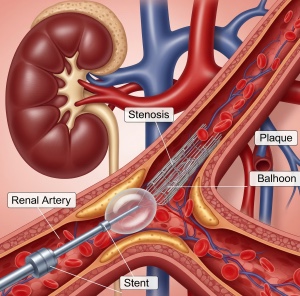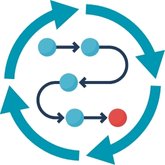Reasons for Heart Attack in Young Age: Dr. Munish Dev’s Guide
Reasons for Heart Attack in Young Age: Dr. Munish Dev’s Guide In today’s fast-paced life,…
Percutaneous Transluminal Renal Angioplasty (PTRA) is a minimally invasive medical procedure used to open blockages or narrowing/stenosis, in the arteries of the kidneys. This procedure is extremely useful for patients who have reduced blood supply to the kidneys, which increases the risk of high blood pressure or kidney failure.
In PTRA, the narrowed artery is dilated using a thin tube (catheter) and a small balloon, so that blood flow can be normalized. In many cases, a stent is also placed in it, which prevents the artery from shrinking again.

PTRA is usually done to treat renal artery stenosis. Renal artery stenosis is a condition when the arteries that supply blood to the kidneys narrow due to atherosclerosis, plaque, or other causes. Problems that occur in this situation:
PTRA is a minimally invasive procedure, i.e. it does not require a major operation. It is usually performed in a cath lab and the patient is given local anesthesia (local sedation).
The process begins with medical evaluation, physical examination, and necessary tests like ECG or angiography to confirm artery blockage and decide if angioplasty is the best treatment option for you.
Once positioned, a tiny balloon at the balloon catheter’s tip is inflated at the blockage site. This widens the artery by pressing plaque against the artery wall to restore blood flow.
Before the procedure, you’ll change into a hospital gown, receive mild sedation, and an intravenous (IV) line will be placed for medications. The insertion site is cleaned and numbed.

A small mesh tube called a stent is placed to keep the artery open. The stent remains permanently, ensuring proper blood circulation and reducing the chance of re-narrowing.
A thin, flexible catheter is inserted into an artery in the wrist or groin. Using X-ray imaging, the doctor carefully guides it toward the blocked renal artery.
After angioplasty, you’ll be observed in a recovery area. Vital signs, heart rhythm, and insertion site are monitored to ensure safe recovery before hospital discharge.
"Recover Right, Stay Healthy – Your Care Starts After the Procedure"
Get expert second opinions from trusted specialists — because your health deserves clarity.
Trusted expertise, advanced technology, and compassionate care make us your best choice for exceptional healthcare.
Trusted expertise delivering advanced, personalized treatments with care, precision, and proven results for your lasting wellness.
Focused on individual needs, our patient-centered treatments ensure personalized care, comfort, and optimal health outcomes.
24/7 expert care for heart emergencies—quick, reliable, and life-saving support when you need it most.
EXCELLENTTrustindex verifies that the original source of the review is Google. I was searching for a Cardiologist in Chandigarh to get my regular heart check up because I was having chest discomfort. I was highly impressed by Dr Munish Dev and his knowledge. He explained each and every report( blood reports as well as echocardiography and ecg) in detail. Highly recommend him for any heart related query.Posted onTrustindex verifies that the original source of the review is Google. I was really anxious about my heart condition, but Dr. Munish Dev’s calm nature and clear guidance put me at ease. The treatment went smoothly, and he kept a close check on my recovery. I truly feel he is the best cardiologist in Chandigarh, and I would recommend him to anyone who needs heart care.Posted onTrustindex verifies that the original source of the review is Google. “After visiting multiple doctors, I finally met Dr. Munish Dev. His approach is very patient-friendly, and he listens carefully before suggesting treatment. With his guidance, my health has improved significantly. No doubt, Dr. Munish Dev deserves the title of the best cardiologist in Chandigarh.”Posted onTrustindex verifies that the original source of the review is Google. “I was experiencing frequent chest discomfort and consulted Dr. Munish Dev. His diagnosis was quick, accurate, and his way of explaining the condition gave me full confidence. Truly, he is the best cardiologist in Chandigarh who combines knowledge with compassion. I highly recommend him to anyone looking for expert heart care.”Posted onTrustindex verifies that the original source of the review is Google. Dr. Munish dev is best cardiologist in entire chandigarh. I was suffering from coronary artery disease. Now I'm seeing best results after his treatment on me. I heartily thank you.Posted onTrustindex verifies that the original source of the review is Google. If you’re searching for the best cardiologist near me, I highly recommend Dr. Munish Dev. His expert diagnosis and compassionate approach truly set him apart. I visited him for a heart consultation, and the entire experience—from consultation to treatment—was smooth, informative, and reassuring.Posted onTrustindex verifies that the original source of the review is Google. Dr. Munish dev was excellent. One of the best cardiologist with awesome team.Posted onTrustindex verifies that the original source of the review is Google. All we know that after God blessings we faith in Doctors. Same thing l reliesed after having a wild heart attack.Dr Munish Dev equalised his stage equal to God in my view. Think he is the best cardiologist in Chandigarh trinity. Being a good doctor he is the best corrodial human being,well manoured person. I love like his thinking and personality.Posted onTrustindex verifies that the original source of the review is Google. Excellent cardiologist, very approachable and trustworthy. Highly recommended.Posted onTrustindex verifies that the original source of the review is Google. He is very intelligent doctor ..my father was here in this world because of him...thanks doctor munish
Show off your recent blog posts in a standard format on the light and soft background with carousal option
Reasons for Heart Attack in Young Age: Dr. Munish Dev’s Guide In today’s fast-paced life,…
Introduction – What is Heart Blockage? Heart disease has become a major concern in today’s…
Heart Attack Symptoms Understanding Heart Attack Symptoms: Early Signs You Shouldn’t Ignore Heart disease remains…
Dr. Munish Dev completed his medical education in MD (Medicine) at the prestigious UCMS & GTB Hospital Delhi. Read More…
©2025 All Rights Reserved.